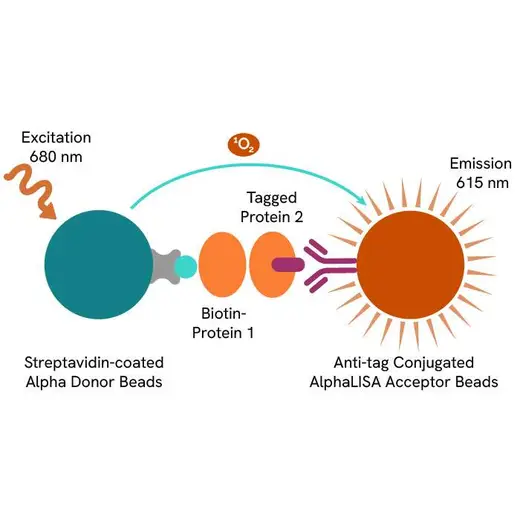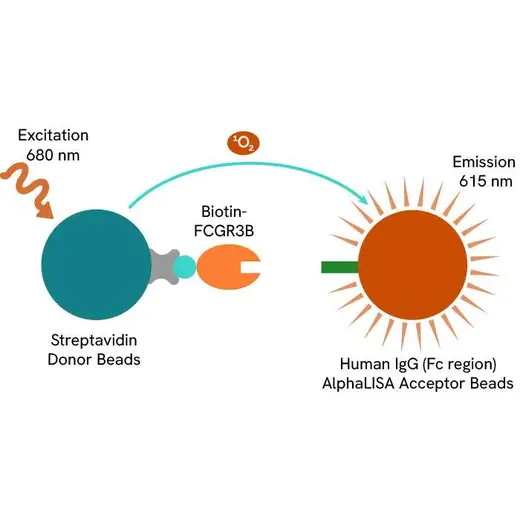
AlphaLISA Human FcRn Binding Kit, 5,000 Assay Points


 View All
View All
AlphaLISA Human FcRn Binding Kit, 5,000 Assay Points














































The AlphaLISA human FcRn binding kit is designed for the detection of binding between FcRn and human IgG using a homogeneous AlphaLISA assay (no wash steps). This assay can facilitate the design and development of antibody therapeutics using a competition assay format.
For research use only. Not for use in diagnostic procedures. All products to be used in accordance with applicable laws and regulations including without limitation, consumption and disposal requirements under European REACH regulations (EC 1907/2006).
| Feature | Specification |
|---|---|
| Application | Protein-Protein Interaction |
| Sample Volume | 10 µL |
The AlphaLISA human FcRn binding kit is designed for the detection of binding between FcRn and human IgG using a homogeneous AlphaLISA assay (no wash steps). This assay can facilitate the design and development of antibody therapeutics using a competition assay format.
For research use only. Not for use in diagnostic procedures. All products to be used in accordance with applicable laws and regulations including without limitation, consumption and disposal requirements under European REACH regulations (EC 1907/2006).























AlphaLISA Human FcRn Binding Kit, 5,000 Assay Points























AlphaLISA Human FcRn Binding Kit, 5,000 Assay Points























Product information
Overview
This kit is designed for the detection of binding between FcRn (neonatal Fc receptor) and human IgG using a homogeneous AlphaLISA assay (no wash steps). This assay can facilitate the design and development of antibody therapeutics using a competition assay format.
AlphaLISA features:
- No-wash steps, no separation steps
- Ease-of-use: few addition steps, fast assay development
- Broad range of affinities: detect strong or weak interactions, from pM to mM affinity
- Distance: measure very large protein or antibody complexes – spanning up to 200 nm or more
- High avidity: multiple binding sites on each bead enables use of nanomolar concentrations of antibodies or proteins, as well as use of low affinity binders
Human FcRn also known as Neonatal Fc receptor is a heterodimer of FCGRT (Fc Fragment of IgG Receptor and Transporter) and B2M (beta 2 microglobulin). Among several Fc receptors known to interact with IgG antibodies, FcRn plays a critical role in maintaining IgG homeostasis. After IgG binds to its target on the cell surface, it is pinocytozed to the endosome where FcRn binds to the antibodies at acidic pH (6.0) and recycles the antibodies back into circulation at physiological pH (7.4). The pH dependency of FcRn binding comes mostly from histidine residues His 310, His 435, and His 436 of IgG, which are protonated at pH 6 creating a strong interaction with the anionic pocket of FcRn; they are neutralized at pH 7.4 releasing IgG from FcRn. As a result, antibodies can be protected from lysosomal degradation, leading to enhanced in vivo stability and efficacy. Hence, profiling of FcRn binding is commonly required by regulatory agencies.
AlphaLISA detection of FcRn and IgG binding uses human IgG AlphaLISA™ Acceptor beads and Streptavidin-coated Donor beads to capture biotinylated human Fc receptor. Donor beads and Acceptor beads come into proximity through IgG Fc fragment binding to FcRn. Excitation of the Donor beads provokes the release of singlet oxygen that triggers a cascade of energy transfer reactions in the Acceptor beads, resulting in a sharp peak of light emission at 615 nm.
Specifications
| Application |
Protein-Protein Interaction
|
|---|---|
| Automation Compatible |
Yes
|
| Brand |
AlphaLISA
|
| Detection Modality |
Alpha
|
| Product Group |
Kit
|
| Sample Volume |
10 µL
|
| Shipping Conditions |
Shipped in Blue Ice
|
| Target Class |
Binding Assay
|
| Target Species |
Human
|
| Technology |
Alpha
|
| Unit Size |
5,000 Assay Points
|
Image gallery






















AlphaLISA Human FcRn Binding Kit, 5,000 Assay Points






















AlphaLISA Human FcRn Binding Kit, 5,000 Assay Points






















Video gallery

AlphaLISA Human FcRn Binding Kit, 5,000 Assay Points

AlphaLISA Human FcRn Binding Kit, 5,000 Assay Points

Resources
Are you looking for resources, click on the resource type to explore further.
Advance your autoimmune disease research and benefit from Revvity broad offering of reagent technologies


How can we help you?
We are here to answer your questions.






























